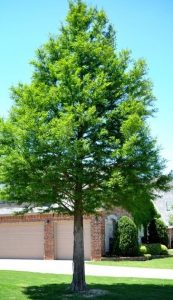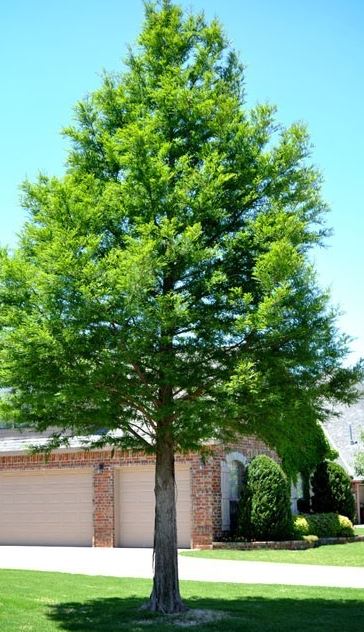
Bald Cypress Taxodium distichum trees may seem most at home in swampy areas, but this tree can thrive in almost any yard. As it loses its needles in the winter, this species is unusual among trees that have cones. If soil conditions are right, this tree could become the centerpiece of your yard.
Bald cypress trees grow at a moderate pace of about one to two feet per year. If given plenty of water, the growth rate could increase. At maturity, they can measure anywhere from 50 to 70 feet in height with a width of between 20 and 30 feet. As fall draws near, the needles on the tree turn russet red and start to fall. New needles will appear in the spring. Leaves need to be cleaned up under large trees before they form thick mats that can keep the grass below from receiving the water it needs.
This tree loves full sun exposure, though it can tolerate partial shade conditions. Typically, at least four to six hours of direct sunlight are recommended every day. Bald cypress trees show a distinct preference for acidic soil. In fact, if the soil gets too alkaline, then the needles may start to turn yellow. Soil amendments to improve acidity may help with this issue.
Bald Cypress – A Great Native Tree of Texas
Bald cypress can produce “knees” the root structures that grow above ground. The knees can be removed as long as they aren’t in the part of the root zone that is critical and if you don’t remove too many at one time. Knees tend to form where there is a lot of water. The function of the knees is not completely understood but speculation is that they increase the aeration to the roots and/or help anchor the trees in wet muddy areas where the tree might be less stable.
Bald cypress is the state tree of Louisiana, where it thrives in swamps. It also is found in Texas swamps, but it can do very well in parks and landscapes throughout northeast Texas. These trees can live for hundreds of years, so it makes sense to plant them carefully. They become giants that can cause problems if they are placed too close to structures.
Like all trees, bald cypress is susceptible to certain diseases and pests. The most common problems include twig blight, which is a fungal disease that causes spots on the needles, bark, and cones. Red spider mites and gall forming mites are frequent problems. As they feed on the foliage, the needles become pale or yellow. Certain types of moths also may cause damage to these trees.
A bald cypress can be an imposing sight in any yard. They provide drama and elegance, along with plenty of shade on hot summer days. Of course, providing proper care is essential to their health. Soil conditions, hydration levels and exposure to sunlight can all play parts in how well a bald cypress does in a given spot.
When problems arise with these trees, it is vital to seek professional assistance at once. This can prevent a small issue from becoming a major headache. It also means that the bald cypress tree can survive and thrive for decades to come.
Cypress trees should be fertilized regularly. You can scatter some granular balanced fertilizer around the drip line. A superior way to fertilize would be root level injections of fertilizer that can give them the nutrients they need for a growing season. For more about root level fertilization (also known as Deep Root Feeding), check out this article about Deep Root Feeding at Green Top Lawn Care.
